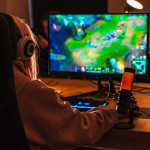Investigating Social Presence in “In Real Life” Streaming for Community Building
Communication and Technology Gaming
Live streaming is a popular form of entertainment that first gained popularity with gaming and e-sports on Twitch. Live streams later grew to include a wide variety of content across Facebook, Instagram and YouTube.
Since 2019, a leading genre of streaming is In Real Life (IRL) streaming, in which streamers broadcast their daily activities to viewers, revealing intimate and authentic portrayals of their lives and activities. IRL streams became especially popular during the COVID-19 pandemic, with 1.5 billion total hours viewed in the first half of 2021. One reason IRL may have skyrocketed during the pandemic is people’s desire to seek social connections and find a community during social isolation.
Even after the pandemic, IRL remains popular. These live stream communities flourish with the exchange of emotions and behaviors, which also dictate group norms and shape how participants identify with the community. IRL streaming is a unique example of social media with “asymmetrical communication affordances”—that is, communication ability is not equal between the streamer and the viewers. While the streamer is visible to all viewers at all times, the viewers outnumber the streamers and are limited in the ways that they can communicate with each other.
To better understand how IRL stream-based community identification is affected by the social presence afforded by the asymmetrical platform, University of Florida College of Journalism and Communications Associate Professor Yu-Hao Lee and Chien Wen (Tina) Yuan and Nanyi Bi of National Taiwan University conducted a survey of 423 IRL viewers. Social presence is more than simply a sense of “being with” other people in mediated environments—it’s a concept that can be further distinguished into three levels based on mutual awareness and dependencies: cognitive copresence, psychological involvement and behavioral interdependence.
Cognitive copresence is the most basic form of social presence. With live streaming, it can be as straightforward as seeing the number of viewers watching a stream. However, the researchers found that copresence was not enough for participants to form a sense of community identification.
Psychological involvement includes more complex psychological aspects such as understanding emotions or motivations. In live streams, this comes into play when streamers share intimate topics or when viewers prompt the streamer or engage with each other through chat features. Viewers who felt a deeper connection and engagement with the streamer were more likely to identify with the community. However, psychological involvement with other viewers were insufficient to support community identification, perhaps due to the limited communication affordances between users.
Behavioral interdependence is the perceptions of interdependence between users, which may involve actions like reactions, emojis and comments. This deeper level of social presence depends on other people responding and reacting to group action. The study also found that behavioral interdependence with other viewers significantly influenced community identification. When viewers engaged with other users in the chat box, made donations, or participated in group activities, they were more likely to identify with the community.
The researchers also explored the relationship between streaming use intensity, social presence, and community identification. They found that higher levels of streaming use intensity were positively associated with social presence dimensions and community identification. This suggests that the more time viewers spend engaging with the platform and its content, the stronger their sense of social presence and community identification becomes.
The original article, “Investigating Social Presence in “In Real Life” Streaming for Community Building,” was published online in New Media & Society on June 12, 2023.
Authors: Yu-Hao Lee, Chien Wen (Tina) Yuan, Nanyi Bi
The summary was written by Jessica Berube, CJC M.A.M.C. 2021
Posted: August 23, 2023
Insights Categories:
Communication and Technology, Gaming
Tagged as: social presence, streaming, Yu-Hao Lee


